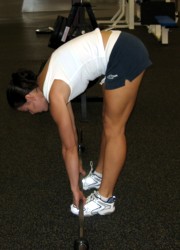1. They both know what the hell they are doing.
2. I've learned more valuable information from them for free than I could ever imagine.
3. I'm sure they don't care what I say or think... yet.
Coach Tumminello first stated that “Everyone is talking about assessments (and that’s cool). But, no one seems to talking about simply not allowing poor form in training. If you can’t keep good form in a certain exercise (movement pattern), simply don’t do that exercise until you’ve improved the movement or decided that you’re simply not built for it to begin with. Not sure why things need be any more complicated than that!”
I couldn't agree more with this statement.. Too often trainers and coaches allow form that is not only sub-par but just hideous. Like lifting with a flexed lumbar spine.. However I don't think it's wise to just start coaching a movement without knowing whether or not it's even something the client should be doing or has the capability of doing. For example if someone is ASLR 1-3 .. This person is NOT deadlifting in my program for them... YET. I can tell them to push their hips back and coach them to death and it ain't happenin'. However if it takes me more than 2 or 3 sessions to correct that and get them deadlifing, than I'm not doing my job properly.

This statement got taken WAYY out of context to the point people were assuming we should only just jump right into exercise with clients... and that Nick was saying dont' assess at all.
Eric correctly points out in this blog that this is definitely not the case and that he believes there are plenty of instances where you should do a thorough assessment first. He also point to a specific "case study" if you will where "someone can have crazy short hip flexors and still manage a perfect squat pattern because his stiffness at adjacent joints is outstanding. If I don’t assess him in the first place and just assume that he squats well, I’m just waiting for him to strain a rectus femoris during sprinting or any of a number of other activities. Gross movement in a strength and conditioning program wouldn’t tell me anything about this individual, but targeted assessments would."
Here's where I think most fitness professional make the mistake is that they WOULD stop there and not check anything else. Now again not to take what Eric is saying out of context because if you have seen the DVD Assess and Correct you know he is doing a VERY detailed assessment on clients and athletes, I think we should start with screenings and THEN move to assessments.
Those that know me know I prefer the movement based approach to screening that is used in the FMS. I also believe this is a perfect example of how for even a trainer in a commercial gym the FMS can save you a lot of time and effort and direct you where to go. Although he nailed a deep overhead squat here is what Eric's client looked like in Thomas Test...

No way this guy is getting past a 1 on the Hurdle Step or the In Line Lunge looking like that. Depending on the rest of the score of his FMS you could then shortcut a lot of steps and jump right to Thomas and FABER...etc to give you a better idea of where to go.
It's important to remember that the FMS is NOT a diagnostic tool or an assessment. It is exactly what it is labeled, a screen. Getting back to both Eric and Nick's points I think the FMS is the perfect solution to both statements. It keeps it fairly simple as Nick is stating is needed and also if used properly won't let a guy like this slip through without finding a fairly obvious problem.
As Gray Cook states we want this to be "as simple as possibly, but not any simpler." My recommendation to fitness professionals out there is NOT to worry about doing every single orthopedic assessment known to man. Use the FMS, assess any movement patterns that screen as dysfunctional using whatever skill set you have, and then move on. In short here's my prescription..
Screen--->Assess (If needed)---> Correct---> Re-Screen---> Train to maintain/strengthen that movement pattern.